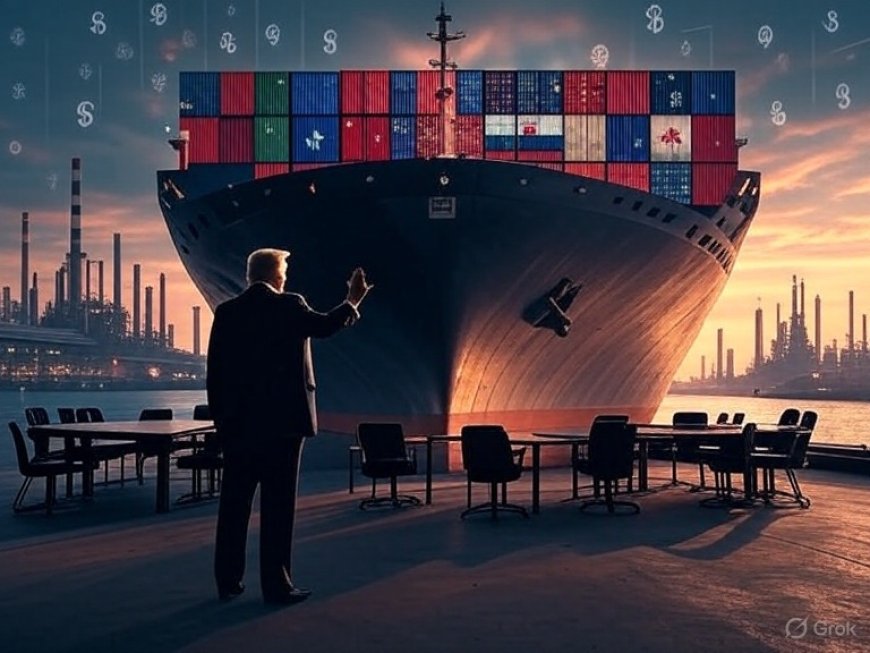Tariffs as Trump’s New Diplomacy: How Trade Became America’s Foreign Policy Tool
President Trump is using tariffs as a central tool of U.S. diplomacy, reshaping trade talks, industry promises, and foreign policy strategy.

President Donald Trump has once again redefined the language of American foreign policy. Instead of relying on alliances, summits, or military presence, the administration has turned tariffs into its primary tool of statecraft. From Beijing to Brussels, Washington’s economic signals are no longer subtle; they come in the form of import taxes that cut directly into global markets.
This pivot marks a striking departure from decades of U.S. diplomacy. Where past administrations used negotiations, aid, or security guarantees to manage relations, Trump is leaning heavily on economic pressure to extract concessions and demonstrate strength.
Tariffs as Policy, Not Punishment
Traditionally, tariffs were treated as narrow instruments of trade disputes. Now, they are applied as multipurpose tools—punishment, incentive, and bargaining chip all rolled into one.
Earlier this summer, the White House imposed new duties on steel and aluminum imports from several nations, citing national security concerns. While critics argue the policy risks retaliation, supporters see it as a way to bolster domestic industry while forcing foreign governments back to the negotiating table.
According to the Office of the U.S. Trade Representative, the administration’s strategy is “to ensure American workers and companies are no longer disadvantaged by outdated agreements and unfair practices.” That framing reflects a broader shift: trade policy as diplomacy itself.
Case Study: China and the Technology Dispute
China remains the clearest example. After years of negotiations under multiple administrations, Beijing’s state subsidies and intellectual property policies still rankle American officials. Trump’s response has been to bypass prolonged talks and instead slap tariffs on billions of dollars’ worth of Chinese goods.
The move has not only pressured Beijing economically but also reset the tone of U.S.–China relations. Where earlier presidents emphasized dialogue, the Trump administration presents tariffs as leverage for concessions—sometimes coupled with ultimatums.
Critics worry this tit-for-tat dynamic could destabilize global markets. Yet Trump’s supporters argue the approach has brought issues to the forefront that were long ignored.
Domestic Industry as Foreign Policy
The other dimension of tariff diplomacy is its domestic appeal. By emphasizing tariffs as a tool to protect American manufacturing, Trump is tying foreign policy directly to his economic agenda. The administration has repeatedly pointed to revitalization promises in states where industries like steel, automobiles, and semiconductors remain politically and economically vital.
This linkage between international negotiation and local revival is deliberate. In Trump’s view, strong diplomacy means visible benefits at home. Factories reopened or jobs preserved are cast not as economic outcomes alone, but as victories in foreign policy.
Reactions at Home and Abroad
The policy shift is dividing Washington. Some lawmakers insist tariffs risk alienating allies and pushing competitors like China closer to other powers. Others argue that without tariffs, traditional negotiations have failed to bring substantive change.
Internationally, reactions range from quiet frustration in European capitals to counter-tariffs in Asia. Analysts note that allies like Japan and South Korea—long used to military coordination—are now grappling with tariffs as the new baseline for U.S. engagement.
The World Trade Organization has already fielded multiple complaints over American measures, underscoring the tension between unilateral tariff diplomacy and multilateral trade rules.
A Calculated Gamble
Tariff diplomacy is, in many ways, a gamble. It assumes that economic pain can be translated into diplomatic leverage without spiraling into uncontrolled trade wars. Supporters say the results are measurable—bringing reluctant partners back to the table, re-centering U.S. industry, and projecting strength abroad.
Critics, however, warn that relying too heavily on tariffs risks undermining America’s alliances and entrenching a reputation as an unpredictable actor on the world stage.
Conclusion
In the past, U.S. presidents employed a mix of military, economic, and diplomatic tools to shape global affairs. Trump’s reliance on tariffs marks a sharp rebalancing, one that fuses domestic politics with foreign strategy. Whether this approach redefines diplomacy for the long term or proves a temporary experiment will depend on how other nations adapt—and how resilient American industries prove to be.
As one veteran trade negotiator observed: “This isn’t diplomacy in the traditional sense. It’s transactional politics at a global scale. And like any transaction, the costs will eventually come due.”
What's Your Reaction?
 Like
0
Like
0
 Dislike
0
Dislike
0
 Love
0
Love
0
 Funny
0
Funny
0
 Angry
0
Angry
0
 Sad
0
Sad
0
 Wow
0
Wow
0







































































